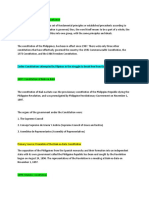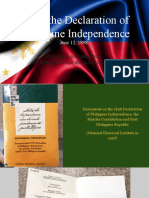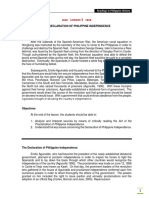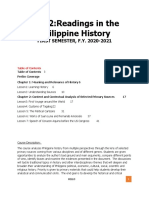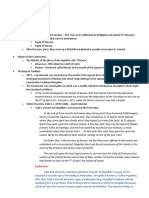Group 2 Evolution of Philippine Constitution
Group 2 Evolution of Philippine Constitution
Uploaded by
Zion WilliamsonCopyright:
Available Formats
Group 2 Evolution of Philippine Constitution
Group 2 Evolution of Philippine Constitution
Uploaded by
Zion WilliamsonOriginal Description:
Copyright
Available Formats
Share this document
Did you find this document useful?
Is this content inappropriate?
Copyright:
Available Formats
Group 2 Evolution of Philippine Constitution
Group 2 Evolution of Philippine Constitution
Uploaded by
Zion WilliamsonCopyright:
Available Formats
1973-1987
• The former president Ferdinand E. Marcos
officially declared the 1973 Philippine
Constitution in full force and effective after
signing Proclamation No. 1102 on January
17, 1973.
• Martial law was declared.
• Presidential-Parliamentary form of
government.
• Abolish the Philippine congress and change
it into Batasan Pambansa/National
Assembly.
• The president would serve a six-year term
and could be re-elected to an unlimited
number of terms.
Parliamentary style of government, unicameral assembly
• President Corazon Aquino created a Freedom
constitution Proclamation No. 3, s.1986 and
issued Proclamation No.9 which created the
Constitutional Commission tasked to draft a
new constitution.
• Approved on February 2, 1987 through a
plebiscite and it was proclaimed in force on
February 11, 1987.
• The reinstatement of democracy, maintaining
the reliable system of checks and balances
among three branches of the government.
• Empowered the voice through strengthening
the freedom of speech and expression.
Post Martial Law and the Present Constitution in the Philippines
The President has 6 years, 1 term in office
• During the Philippine Revolution, the biak na bato
constitution served as the provisional
constitution of the Philippines.
• Emilio Aguinaldo built his headquarters at Biak na
Bato, San Miguel de Mayumo, Province of Bulacan.
• Aguinaldo founded the Biak-na-Bato Republic in
July 1897, issuing a proclamation that stated the
following demands:
• Expulsion of the friars and the return of the friar
lands to the Filipinos
• Representation of the Philippines in the Spanish
Cortes
• Freedom of the press and of religion
• Abolition of the government’s power to banish
Filipinos
• Equality for all before the law.
• On November 1, 1897 The Biak-na-Bato Constitution
provided for the establishment of a Supreme council
that would serve as the highest governing body of the
Republic.
• Emilio Aguinaldo and Mariano Trias were elected
Supreme Council president and vice president.
• Felix Ferrer and Isabelo Artacho wrote a charter that was
based on the Cuban Constitution.
• Pedro Paterno, a Spaniard born in the Philippines
volunteered to act as negotiator between Aguinaldo and
Gov. Primo de Rivera in order to end the clashes.
• Aguinaldo and the Spanish army signed an agreement
that if Aguinaldo went into exile and surrendered his
armaments, the Spanish government would grant the
Philippines (1) self-rule in three years. (2)Aguinaldo
would get P800,000 (Mexican Pesos) in compensation for
the revolutionaries as well as amnesty in exchange.
• Filipinos and Spaniards did not trust each other, the
Biak-na-Bato Pact failed.
• The separation of the Philippines from the Spanish
monarchy and their formation into an independent state
with its own government called the Philippine Republic
has been the end sought by the Revolution in the existing
war, begun on the 24th of August, 1896; and therefore,
in its name and by the power delegated by the Filipino
people, interpreting faithfully their desires and
ambitions, we, the representatives of the Revolution, in a
meeting at Biak-na-bato, Nov. 1st. 1897, unanimously
adopted the following articles for the Constitution of the
State.
• The Political Constitution of 1899.
• Basic law of the first Philippine Republic;
first republican constitution among Asian
Countries.
• It was drated by the committee headed by
Felipe Calderon, Cayetano Arellano.
• The framework of the constitution was based
on constitutions of Mexico, Guetamela, costa
Rica, Brazil, Belgium, and France.
• Malolos, a city of the province of Bulacan;
was the capital of the Filipino revolutionary
government.
• It was the fruit of the proclamation of the
Philippine independence in Kawit, Cavite on
June 12, 1898.
• We, the Representatives of the Filipino people,
lawfully convened, in order to establish justice,
provide for common defense, promote the general
welfare, and insure the benefits of liberty,
imploring the aid of the Sovereign Legislator of the
Universe for the attainment of these ends, have
voted, decreed, and sanctioned.
• The Commonwealth of the Philippines was the
administrative body that governed the
Philippines from 1935 to 1946, aside from a
period of exile in the Second World War from
1942 to 1945 when Japan occupied the
country.
• The Commonwealth was the culmination of
efforts to secure a definitive timetable for the
withdrawal of American sovereignty over the
Philippines.
• The Commonwealth Constitution of the
Philippines provided for a presidential system
of government with a unicameral legislature. It
had the power to enact laws for the Philippines,
known as Commonwealth Acts, through the
National Assembly.
• When both the Senate and the House pass a measure in the
same form, it is sent to the president for signature. The bill
becomes law if the president signs it. Acts of Congress are
another name for laws. Another word that is used
interchangeably with law is statute.
• When the president signs a law, it is assigned a number that
corresponds to the order in which it was signed. P.L.107-101
is a citation to a public legislation, with 107 denoting that it
was passed during the 107th Congress and 101 denoting its
number designation. A private law is defined similarly to a
public law, except the word "private law" is used instead of
"public law."
• Public and private laws are printed as slip laws–which are
single sheets or pamphlets containing the text of the law.
• What does the Congress do?
• Make laws
• Declare war
• Raise and provide public money and oversee its proper
expenditure
• Impeach and try federal officers
• Approve presidential appointments
• Approve treaties negotiated by the executive branch
• Oversight and investigations
• We the Filipino people ordain and promulgate this
constitution, asking Divine Providence's help to
establish a government that will embody their
ideals.
• Preserve and develop the nation's patrimony,
promote the general welfare, and secure the
blessings of independence under a régime of justice
liberty, and democracy for themselves and their
descendants
• The 1973 constitution consists of a preamble and 17 articles that provides
for the shift from presidential to parliamentary system of government.
• The presidential decree no.73 was issued by president Marcos to ratify or
reject the proposed constitution in November 1973. However this was
postponed due to the fact that president Marcos feared that the people
might go against the constitution therefore he held a citizen assembly.
January 1973 president Marcos proclaimed that the constitution was
ratified.
• The 1973 constitution was a way for the president to abolish the senate and
act as an authoritarian presidential system with all power concentrated in
him and backed by the constitution.
• The head of government and commander-in-chief of the Philippine Armed
Forces is elected by the members of the National Assembly as the Prime
Minister. The President is elected from the National Assembly's members
and acts as the country's symbolic head of state for six years.
• "We, the sovereign Filipino people, imploring the aid
of Divine Providence, in order to establish a
Government that shall embody our ideals, promote
the general welfare, conserve and develop the
patrimony of our Nation, and secure to ourselves
and our posterity the blessings of democracy under
a regime of justice, peace, liberty, and equality, do
ordain and promulgate this Constitution."
CONSTITUTION AFTER MARTIAL LAW
• The new constitution was proclamed ratified and took
effect on February 11, 1987.
• establishes the Philippnes as a "democratic and
republican State", where 'sovereignty resides in the
people and all government authority emanates from
them."
• Corazon Aquino issued Proclaimation no. 3.
• The 1987 Constitution established a representative
democracy with power divided among three separate
and independent branches of government: the
Executive, a bicameral Legislature, and the Judiciary.
There were three independent constitutional
commissions as well: the Commission on Audit, the Civil
Service Commission, and the Commission on Elections.
Integrated into the Constitution was a full Bill of
Rights, which guaranteed fundamental civil and and
political rights, and it provided for free, fair, and
periodic elections.
• The President and Vice President are members of
the Executive branch, and they are chosen by direct
public vote for a six-year tenure. The President has
the power to nominate his Cabinet, according to the
Constitution. These agencies make up a significant
component of the country's bureaucracy.
• The President, Vice President, Cabinet, executive
departments, independent agencies, boards,
commissions, and committees are all part of this
structure.
• Through the power vested in the Philippine
Congress, the Legislative branch is permitted to
enact, amend, and abolish laws. The Senate and the
House of Representatives are the two branches of
this government.
• The Legislative Branch is in charge of enacting laws,
confirming or rejecting Presidential nominations, and
declaring war.
• The House of Representative.
• The Judicial branch holds the power to settle
controversies involving rights that are legally
demandable and enforceable. This branch
determines whether or not there has been a grave
abuse of discretion amounting to lack or excess of
jurisdiction on the part and instrumentality of the
government. It is made up of a Supreme Court and
lower courts.
• The judicial branch interprets the meaning of laws,
applies laws to individual cases, and decides if laws
violate the Constitution. The judicial power shall be
vested in one Supreme Court and in such lower
courts as may be established by law.
• Constitutional reform in the Philippines, also known as
charter change, refers to the political and legal processes
needed to amend the current 1987 Constitution of the
Philippines. Under the common interpretation of the
Constitution, amendments can be proposed by one of
three methods: a People's Initiative, a Constituent
Assembly or a Constitutional Convention.
• A fourth method, by both houses passing a joint
concurrent resolution with a supermajority of at least
75%.
• Article XVII of the Constitution of the Philippines (1987)
• The first attempt to amend the 1987 Constitution was under President
Fidel Ramos. Among the proposed changes included a shift to a
parliamentary system and lifting of term limits. On September 21, 1997,
a church-organized rally brought in an estimated half a million people to
Rizal Park.
• People's Initiative for Reform, Modernization and Action (PIRMA) sought
to amend the Constitution through a signature campaign or People's
Initiative. In 1997, the Supreme Court narrowly dismissed a petition filed
by PIRMA seeking changes to the 1987 constitution. Had the petition
been successful, a national plebiscite would have been held for
proposed changes.
• A similar attempt to amend the 1987 constitution was made under
President Joseph Estrada. CONCORD, or Constitutional Correction for
Development, is the name of the process. Unlike Ramos and Arroyo's
Constitutional Reform, the CONCORD proposal, according to its
proponents, would simply change the constitution's restrictive
economic sections, which are thought to obstruct the admission of
more international capital into the Philippines.
• Opposition politicians, religious sects, and left-wing organizations
raised objections based on a variety of factors, including national
patrimony and the proposed constitutional changes being self-serving.
The government was once again accused of promoting constitutional
revision for its own benefit.
• A system of government under which significant
government powers are shared between the National
and Regional/State Governments.
• Federalism divides the country into several autonomous
states with a national government.
• The states are further divided into local government
units.
• The Federal System in the Philippines has 4 principles;
Power Sharing, Resource Sharing, Respect for all, and
Development for all (PRRD).
https://iracing.fandom.com/wiki/Republic_of_Biak-na-Bato
https://www.youtube.com/watch?v=eqVyI_8G22k&t=517s
https://www.philippine-history.org/biak-na-bato.htm
https://slideplayer.com/slide/17984344/
https://thecorpusjuris.com/constitutions/1897-constitution.php
https://www.officialgazette.gov.ph/constitutions/constitution-day/
https://en.wikipilipinas.org/view/Malolos_Constitution
https://www.lawphil.net/consti/consmalo.html
https://www.senate.gov/pagelayout/legislative/one_item_and_teasers/Laws_and_Acts_page .htm
https://www.visitthecapitol.gov/about-congress/what-congress-does
https://www.foreignaffairs.com/articles/philippines/1935-07-01/new-constitution-philippine-commonwealth?amp
https://www.slideshare.net/sameng/constitution-of-the-philippines-1973-presentation
https://www.scribd.com/presentation/426387913/1973-Constitutional-Authoritarianism
https://lawphil.net/consti/cons1973.html
https://www.gov.ph/about-the-government.html
https://en.m.wikipedia.org/wiki/Constitutional_reform_in_the_Philippines
You might also like
- The Act of The Declaration of Philippine Independence: Ambrosio Rianzares Bautista100% (1)The Act of The Declaration of Philippine Independence: Ambrosio Rianzares Bautista19 pages
- RPH 113 - 10 1935 The Commonwealth ConstitutionNo ratings yetRPH 113 - 10 1935 The Commonwealth Constitution5 pages
- Module 2 For Gen Ed 9 Rizal (WEEK 2) 4A'S FORMATNo ratings yetModule 2 For Gen Ed 9 Rizal (WEEK 2) 4A'S FORMAT9 pages
- Presedent Corazon Aqiuno's Specch Before The U.S. CongressNo ratings yetPresedent Corazon Aqiuno's Specch Before The U.S. Congress26 pages
- Readings in Philippine History 3 PDF VERSION PDF100% (1)Readings in Philippine History 3 PDF VERSION PDF101 pages
- Documents of The 1898 Declaration of Philippine IndependenceNo ratings yetDocuments of The 1898 Declaration of Philippine Independence21 pages
- Commission On Indepence Filipino Grievances Against GovernorNo ratings yetCommission On Indepence Filipino Grievances Against Governor21 pages
- Act of The Declaration of Philippine Independence: Acta de La Proclamación de Independencia Del Pueblo Filipino100% (1)Act of The Declaration of Philippine Independence: Acta de La Proclamación de Independencia Del Pueblo Filipino34 pages
- Toaz - Info The Assassination of Antonio Luna Reportdocx PRNo ratings yetToaz - Info The Assassination of Antonio Luna Reportdocx PR13 pages
- Module 2 - Lesson 6 The Act of Declaration of Philippine IndependenceNo ratings yetModule 2 - Lesson 6 The Act of Declaration of Philippine Independence25 pages
- The Declaration of Philippine IndependenceNo ratings yetThe Declaration of Philippine Independence7 pages
- Evolution of The Philippine ConstitutionNo ratings yetEvolution of The Philippine Constitution47 pages
- GROUP 4 - PPT (Cry of Rebellion & Agrarian Reform)No ratings yetGROUP 4 - PPT (Cry of Rebellion & Agrarian Reform)32 pages
- Readings in The Philippine History - Lesson 7No ratings yetReadings in The Philippine History - Lesson 76 pages
- Unit 2: Content and Contextual Analysis of Selected Primary Sources in The Philippine HistoryNo ratings yetUnit 2: Content and Contextual Analysis of Selected Primary Sources in The Philippine History6 pages
- President Corazon Aquino's Speech Before The U.S. CongressNo ratings yetPresident Corazon Aquino's Speech Before The U.S. Congress9 pages
- Group 10 - The 1973 Constitution Written Report (RPH)No ratings yetGroup 10 - The 1973 Constitution Written Report (RPH)13 pages
- The Philippines Before The Arrival of SpainNo ratings yetThe Philippines Before The Arrival of Spain8 pages
- Lesson 2 Content and Contextual Analysis of Selected Primary Sources in Philippine HistoryNo ratings yetLesson 2 Content and Contextual Analysis of Selected Primary Sources in Philippine History10 pages
- GEC 2:readings in The Philippine History: FIRST SEMESTER, F.Y. 2020-2021100% (2)GEC 2:readings in The Philippine History: FIRST SEMESTER, F.Y. 2020-202131 pages
- 1935 Commonwealth Constitution (Tydings Mcduffie)No ratings yet1935 Commonwealth Constitution (Tydings Mcduffie)9 pages
- 03 01 ARTICOL Classification System For The Completely Dentate PatientNo ratings yet03 01 ARTICOL Classification System For The Completely Dentate Patient10 pages
- English3-Quarter 2-Week 5-QARODEL-see CommentNo ratings yetEnglish3-Quarter 2-Week 5-QARODEL-see Comment8 pages
- Experiment: Schematic of Linear Variable Differential Transformer (LVDT)No ratings yetExperiment: Schematic of Linear Variable Differential Transformer (LVDT)15 pages
- Subgroup Analysis in Regression Discontinuity DesignsNo ratings yetSubgroup Analysis in Regression Discontinuity Designs14 pages
- Assessment Template - BSBINS601 - Task1 & 2No ratings yetAssessment Template - BSBINS601 - Task1 & 221 pages
- Test Bank For Learning and Memory 4th Edition Terry100% (49)Test Bank For Learning and Memory 4th Edition Terry6 pages
- Neural Networks For Modeling and Identification of The Dough Rising Process Inside An Industrial Proofiing ChamberNo ratings yetNeural Networks For Modeling and Identification of The Dough Rising Process Inside An Industrial Proofiing Chamber6 pages
- Mayor As Minimum, To Two (2) Years, Four (4) Months and One (1) Day of Prision Correccional AsNo ratings yetMayor As Minimum, To Two (2) Years, Four (4) Months and One (1) Day of Prision Correccional As2 pages
- The Act of The Declaration of Philippine Independence: Ambrosio Rianzares BautistaThe Act of The Declaration of Philippine Independence: Ambrosio Rianzares Bautista
- Presedent Corazon Aqiuno's Specch Before The U.S. CongressPresedent Corazon Aqiuno's Specch Before The U.S. Congress
- Documents of The 1898 Declaration of Philippine IndependenceDocuments of The 1898 Declaration of Philippine Independence
- Commission On Indepence Filipino Grievances Against GovernorCommission On Indepence Filipino Grievances Against Governor
- Act of The Declaration of Philippine Independence: Acta de La Proclamación de Independencia Del Pueblo FilipinoAct of The Declaration of Philippine Independence: Acta de La Proclamación de Independencia Del Pueblo Filipino
- Toaz - Info The Assassination of Antonio Luna Reportdocx PRToaz - Info The Assassination of Antonio Luna Reportdocx PR
- Module 2 - Lesson 6 The Act of Declaration of Philippine IndependenceModule 2 - Lesson 6 The Act of Declaration of Philippine Independence
- GROUP 4 - PPT (Cry of Rebellion & Agrarian Reform)GROUP 4 - PPT (Cry of Rebellion & Agrarian Reform)
- Unit 2: Content and Contextual Analysis of Selected Primary Sources in The Philippine HistoryUnit 2: Content and Contextual Analysis of Selected Primary Sources in The Philippine History
- President Corazon Aquino's Speech Before The U.S. CongressPresident Corazon Aquino's Speech Before The U.S. Congress
- Group 10 - The 1973 Constitution Written Report (RPH)Group 10 - The 1973 Constitution Written Report (RPH)
- Lesson 2 Content and Contextual Analysis of Selected Primary Sources in Philippine HistoryLesson 2 Content and Contextual Analysis of Selected Primary Sources in Philippine History
- GEC 2:readings in The Philippine History: FIRST SEMESTER, F.Y. 2020-2021GEC 2:readings in The Philippine History: FIRST SEMESTER, F.Y. 2020-2021
- 03 01 ARTICOL Classification System For The Completely Dentate Patient03 01 ARTICOL Classification System For The Completely Dentate Patient
- Experiment: Schematic of Linear Variable Differential Transformer (LVDT)Experiment: Schematic of Linear Variable Differential Transformer (LVDT)
- Subgroup Analysis in Regression Discontinuity DesignsSubgroup Analysis in Regression Discontinuity Designs
- Test Bank For Learning and Memory 4th Edition TerryTest Bank For Learning and Memory 4th Edition Terry
- Neural Networks For Modeling and Identification of The Dough Rising Process Inside An Industrial Proofiing ChamberNeural Networks For Modeling and Identification of The Dough Rising Process Inside An Industrial Proofiing Chamber
- Mayor As Minimum, To Two (2) Years, Four (4) Months and One (1) Day of Prision Correccional AsMayor As Minimum, To Two (2) Years, Four (4) Months and One (1) Day of Prision Correccional As











